Editor’s note: This article originally ran December 21, 2020, and was updated November 20, 2024.
There are good things about winter—holidays, ice skating, hot chocolate—and not-so-good things. Colds. Coughs. Numb toes. Shoveling-induced chest pain.
We could go on, as winter comes with its share of health hazards. But you and your family can stay healthy all season long with these tips from UNC Health family medicine physician Sarah Ruff, MD.
1. Get your annual vaccines to ward off infection.
The best way to avoid serious illness from the flu or COVID-19 is to get vaccinated for both. Doctors recommend getting the flu shot in the fall to protect you all winter. You can get an updated COVID-19 shot at the same time, formulated to match the latest strain.
Virtually everyone ages 6 months and older can receive the flu and COVID-19 vaccines. They’re especially important for people at from these viruses, including older adults and the immunocompromised.
“It’s also important for healthy people to get vaccinated to protect the vulnerable,” Dr. Ruff says.
Talk to your doctor about whether you or your child needs to receive the pneumonia vaccine or an RSV vaccine. Both are recommended for babies and older adults.
2. Protect your heart.
As the temperatures drop, rates of heart disease rise. But there are steps you can take to protect your heart.
First, find opportunities to reduce stress whenever you can. High stress levels elevate your blood pressure, heart rate and breathing rate. These elevated levels in turn can trigger a cardiovascular event, such as a heart attack. Exercise and adequate sleep can help, as can embracing mindfulness. If your stress feels unmanageable, talk to your doctor or find a therapist.
Next, look to your diet. It’s easy to choose less nutritious “comfort” foods in winter, but remember that eating a diet high in saturated fats, trans fats and cholesterol is linked to heart disease. Too much salt and alcohol can raise your blood pressure, which taxes your heart, as does the weight gain that comes from eating too much added sugar.
Finally, take care when exerting yourself outdoors. Cold air may make your arteries constrict, which can decrease blood flow and the delivery of oxygen to your heart. Shoveling snow can be an especially dangerous activity; ask for help if needed.
3. Go outdoors, but dress properly.
Even in winter, it’s healthy to spend time outside. But limiting time in very cold temperatures and dressing properly is critical. A too-low body temperature, known as hypothermia, is dangerous and can lead to cardiac arrest. Older adults and babies, who cannot communicate that they are cold, are most at risk.
Exposed skin in very cold temperatures can lead to frostbite, which in severe cases causes permanent damage to skin and tissue.
“Keep an extra pair of socks, a hat, coat, boots and a blanket in your car so if you get stuck and have to walk somewhere, you’ll be covered,” Dr. Ruff says.
If you have a baby or toddler, monitor the temperature in their bedroom, and remember to dress young children in one more layer than you would an adult, because they get cold easier. But don’t buckle them into car seats in bulky coats; tighten the harness in their base layer and put a blanket on top. Thick, puffy coats can leave the straps too loose to protect the child in case of a crash.
4. Drive with the weather in mind—or stay home.
It’s best to be flexible in the winter and not drive when the roads are not in good condition.
If the temperature is near freezing, precipitation is expected and you must go out, watch out for icy conditions and slow down. Black ice is transparent and thin, so it can be very difficult to see. If black ice is present, the roadway may be darker in some spots and lighter in others. Remember to be especially careful on bridges and overpasses.
Keep an ice scraper in your car and make sure you can see out all your windows before you start driving, Dr. Ruff says.
5. Step with care to avoid falling.
One common cause of winter injuries is falling on slippery surfaces.
“Be really careful where you step when it’s icy, because you can’t even see black ice—it just looks like the street,” Dr. Ruff says.
Avoid carrying heavy loads that may cause you to lose balance, and take your time so you can watch where you are stepping. Wear reflective gear when walking outside in the dark so drivers are more likely to see you.
6. Keep your mental health in mind.
Depression is common year-round, but winter is an especially tricky time for mental health. Less sunlight and time outside can lead to seasonal affective disorder, marked by low mood during the winter months. Winter can be isolating for many, but also brings challenging social situations during the holidays.
If you feel especially sad or anxious during the winter, you don’t have to wait for spring to feel better. Talk to your primary care provider or a therapist, and look for ways to treat yourself with care while you’re struggling.
“Mental health is so important, and I encourage everyone to give it as much attention as you do your heart or skin or lungs,” Dr. Ruff says. “There are ways to feel better if you ask for help.”
To learn more about staying healthy, talk to your doctor or find one near you.

